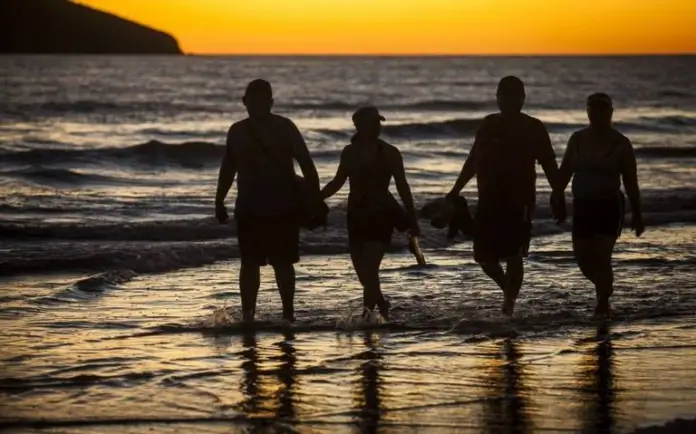The vast majority of Mazatlan beaches are suitable for swimming except for one, Playa Norte
Throughout the Republic, preparations are already underway for summer vacations, and the big question is whether the beaches and coastal resorts in the national territory are suitable for bathers to enter the sea without any problem.
According to the latest Pre-Vacation Beach Monitoring for Easter 2024, Mazatlan beaches are suitable for recreational use.
Each vacation period, the Federal Commission for the Protection against Sanitary Risks, in coordination with state health authorities and the National Network of Public Health Laboratories, takes seawater samples during the weeks prior to the vacation period in order to detect the Enterococcus fecalis bacteria and indicate whether any beach represents a health risk.
The last sampling was carried out from February 26 to March 7 on the beaches of the main tourist destinations in Mexico and those with the highest influx.
In this, the beaches of Mazatlán were found to be suitable for bathers by not exceeding the limit established by the World Health Organization, of 200 enterococci in 100 milliliters of water.
The following beaches were found to be “suitable”:
Playa Cerritos
Playa Zona Dorada I
Zona Dorada III
Zona Dorada IV
Zona Dorada VI
Isla El Venado
Playa del Mar
Los Pinos
Olas Altas
Isla del Chivo
Isla de la Piedra
Playa Norte.
The vast majority were in the range of 10 to 34 NMP/100 ML except for one, Playa Norte, which obtained a measurement of 178 enterococci in 100 milliliters of water.
This is one of the coastal areas most frequented by bathers, the waves are calm most of the year, however, smelly water is continually discharged through a storm drain, whether it is the rainy season or not.
It is not drainage, it is stagnant water
Despite the measurements made by the federal authority, the municipal authority rules out that it is sewage or drainage, and that it is rather water that remains stagnant for months, rots, and when it comes out it has a suspicious color and aroma.
“It is not drainage water, it is dirty rainwater, in the rainy season you see the stream when it rains that falls there and suddenly sometimes the pumping stations in the tourist area are activated, which has happened on some occasions, they are cleaning them and they throw out that water, but it is not sewage, it is not drainage,” said Mayor Edgar González Zataráin.
The mayor assured that work has been done to maintain the quality of the beaches, for example, the Roosevelt collector, which flows into Playa Olas Altas, a section that in the monitoring of the 2023 winter vacation period was found to be unsuitable for recreational use.
In his speech, the authorities did accept that there was a leak of untreated wastewater in the drain, but they minimized it by saying that Cofepris staff had taken the sample incorrectly.
“What was done was not on the beach but on a direct runoff, if you take the direct drainage it will mark you very high (…) it is a runoff that came from some businesses that had the drainage blocked and that were draining into the Roosevelt drain and that obviously went to take the sample there, we should not deny that there is contamination, but that the degrees of contamination of the water are like that, as they mark it not,” declared González Zataráin at that time.
A few months ago and with a million-dollar investment, the replacement of the hydrosanitary pipe on Roosevelt Street began, with which it is ensured that the runoff of residual waters to the pluvial collector is stopped.
“In the problem of the overflows that we had in the part close to the beach and the last one that we had left as a contaminating part was the issue of the Roosevelt collector, which is being repaired very quickly, everything that was those houses, that the drainage that goes along the sidewalk practically did not exist anymore, and the collector is in the middle of the street, and the collector went and fell into the sea, with “With this repair we concluded the problems that could occur in that part,” he said in an interview on June 12.
The State Commission for Protection against Sanitary Risks affirms that the beaches “have come out well,” but without showing results, also that they work together with the Boards to act immediately when a possible contamination is detected.
“We came out well, it is a talk that we had to work in coordination, to avoid all that, if we do a review and find a probable contamination, immediately in coordination with the Drinking Water Board we begin to do the search to be able to solve this problem,” said Cuauhtémoc Chacón Mendoza, head of Coepriss, in an interview on June 28 last year.
Fecal bacteria
Enterococcus feacalis is a bacterium that is commonly found in the intestinal tract of humans and animals, which is why it is used as an indicator of fecal contamination on beaches.
These bacteria can arrive through different routes, the main one being through the direct discharge of wastewater, domestic water, discharge from agricultural sources or through the feces of pets.
The discharge of liquids into the beach and ocean area through the different drains in the coastal area is frequent, these drains that are pluvial discharge water whether it is rainy season or not.
Generally, the discharged liquids have bad odors and have a dark color that calls into question their origin, despite the fact that the pluvial and sanitary waters are carried through different pipes, discharges of black water have been recorded on beaches such as Norte, Olas Altas and Pinitos.
Source: elsoldemexico







